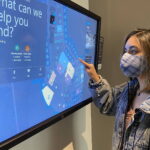 The new Microsoft Guest Management System (GMS) is helping Microsoft make a better first impression at one of its very important front doors—the lobbies of its hundreds of buildings scattered across the globe.
The new Microsoft Guest Management System (GMS) is helping Microsoft make a better first impression at one of its very important front doors—the lobbies of its hundreds of buildings scattered across the globe.
For many guests, a building lobby is the first impression they get of Microsoft, so it’s important to make it a positive experience. After years of using a variety of third-party and self-created visitor management systems (VMS) to manage its lobbies across over 400 buildings, the company developed its own GMS with the goal of creating a quick, seamless, and personalized guest experience for anyone who visits the company in person.
The success of this program is to ensure employees and anyone else visiting a Microsoft building is able to check in efficiently and seamlessly, and for lobby hosts to provide a welcoming environment for guests.
—Katy Flaherty, services manager, Global Workplace Services
“The success of this program is to ensure employees and anyone else visiting a Microsoft building is able to check in efficiently and seamlessly, and for lobby hosts to provide a welcoming environment for guests,” says Katy Flaherty, a services manager on the Global Workplace Services team who manages the lobby experience for Microsoft buildings in the Puget Sound region. “The lobby really is the first impression of Microsoft.”
If the tool doesn’t work for our lobby hosts, then it won’t work for our guests.
—Jessie Go, app manager, Global Workplace Services
[Discover how Microsoft is creating the digital workplace. Learn how Microsoft is accelerating its global real estate transformation. Check out how Microsoft is powering its smart building with Microsoft Azure Digital Twins. Learn how Microsoft is enabling a modern support experience within the company.]
Standardizing guest management
Lobby hosts are the first human touchpoint a guest has when they visit a Microsoft building. To create the best experience possible, these hosts need tools that allow them to put the guest first.
“If the tool doesn’t work for our lobby hosts, then it won’t work for our guests,” says Jessie Go, an app manager on the Global Workplace Services team responsible for deploying a consistent experience at all global Microsoft lobbies.
Our primary goal is to have a global standard and consistent experience for all our guests. We wanted to remove the anxiety of our guests related to visiting our campuses by preparing them well for the visit in advance. This way we could set them up to perform their best and succeed when they are here.
—Vivekanand Pandey, GMS lead program manager, Microsoft Digital
These older systems created privacy, security, and compliance issues. Lobby hosts didn’t have proper visibility into how many people were going in and out of buildings daily, or how many were in a building at any given time. Additionally, the systems didn’t allow for any customizations based on that building’s specific business requirements. These issues resulted in a disjointed guest experience.

Creating a cloud-based, connected experience
The Microsoft Guest Management System is a first-party solution developed in partnership with the Microsoft Digital Employee Experience team. The GMS provides a connected experience through a digital transformation-ready cloud-based architecture. It’s a web-based system powered by Microsoft Azure that integrates with Microsoft Outlook for scheduling a visit with ease and allows guests to easily pre-register and prepare for their visit to campus. The system is built on a React frontend with .NET core backend and Microsoft Azure Cosmos DB for managing data. It uses core Microsoft Azure features like Azure Service Bus, Azure Search Service, Azure Functions-Serverless Apps and Computing, and Azure API Management to deliver the application suite.
“Our primary goal is to have a global standard and consistent experience for all our guests,” says Vivekanand Pandey, the GMS lead program manager for Microsoft Digital, the organization that powers, protects, and transforms the company. “We wanted to remove the anxiety of our guests related to visiting our campuses by preparing them well for the visit in advance. This way we could set them up to perform their best and succeed when they are here.”
The GMS allows guests to check-in on the web or at an arrive kiosk in the lobby. Meeting hosts can send an invite, which records a guest’s upcoming visit in the system and provides a welcome email to the guests to make them familiar with the visitation process. Guests may also access a guest portal to pre-register in advance of their visit, making check-in a breeze when they arrive.
Upon registration, guests are given a universal QR code that allows them to be identified and navigate throughout the building and the campus. The QR code allows a guest to access the building’s turnstile and onsite parking, where enabled, and can even get them a free coffee in the future.
We built a solid, event-driven architecture that offers a modern experience on the front end and where you can easily add new components and features quickly.
—Prabha Kalpathy, principal software engineering manager, Microsoft Digital
To power the GMS, Microsoft opted for an event-driven architecture-based system that is completely serverless. This enabled the team to create the tool cost-effectively while scaling quickly to onboard new locations. What’s more, the components and code are reusable, which allows for easy integrations and modifications, and can be used by other teams through a shared library.
Not only is the back end easy to operate, but the front end is too; it was explicitly designed to deliver a modern user experience. As a result, new workflows and features can be quickly built and customized for each location based on the system’s unique wants and needs.
“We built a solid, event-driven architecture that offers a modern experience on the front end and where you can easily add new components and features quickly,” says Prabha Kalpathy, principal software engineering manager in Microsoft Digital.
Global rollout
Within 20 months, the GMS was built and implemented in Microsoft lobbies around the world, starting in the Puget Sound region. Currently, over 357 sites have been onboarded to the new GMS, with 100 more sites either in the process or planned. Since the rollout, over 1 million guests have been welcomed to Microsoft campuses via the GMS.
Now, check-in is a seamless experience, and lobby hosts are more productive, informed, and helpful in creating a great experience for guests visiting the campus.
“The features and functionality of our buildings do great marketing for us,” Go says. “Guests see the technology solutions and services we provide and want those in their own office buildings.”
The true win with this system is being able to make major and minor customization enhancements on the back end to accommodate site-specific requirements and future business needs.
—Rhonda Cone, facilities management practice lead, Global Workplace Services
The COVID-19 pandemic didn’t slow down rollout; in fact, it allowed for the Employee Experience team to further meet guest needs by creating a touchless, contactless check-in experience via a mobile device. The GMS also allowed for easy and seamless management of a COVID-19 vaccination clinic at one of the Microsoft campuses in the Puget Sound region, which demonstrates its use beyond just for meetings and events.

A new era of transformation
While building the GMS, Microsoft retired its “visitor” nomenclature, instead using “guest” to describe those visiting one of the company’s campuses. This lends itself to a more personal and better connection with guests in order to create a memorable and personalized campus visit.
With a full end-to-end experience, Microsoft can now control and curate features and enhancements to continually adjust to guest and lobby host needs. Working together, teams in Global Workplace Services and Microsoft Digital can adjust the lobby experience from building to building.
“The true win with this system is being able to make major and minor customization enhancements on the back end to accommodate site-specific requirements and future business needs,” says Rhonda Cone, facilities management practice lead on the Global Workplace Services team. She manages the lobby experience for all Microsoft buildings around the globe.
Additionally, Microsoft now can package versions of the GMS as a product to sell to other companies and property managers. It’s a tool that can grow with a company as its customer experience journey changes and as its needs evolve.
The big win is improving the experience guests have when they visit Microsoft, especially for those who are having their first experience with the company.
“We were able to create a solution that’s a balance between hospitality and security,” Go says. “By thinking outside the box and being flexible, we built a personalized, seamless, and easy guest experience for anyone visiting one of Microsoft’s locations around the globe.”

- Know the problem you’re trying to solve.
- Research the steps you will need to take to get where you want to go.
- Understand your customers and their needs so you can keep them at the center of your solution.
- Understand the products and capabilities available in the market that you can use to shape your product.
- Try to find a good balance between hospitality and security.
- Be flexible and creative when it comes to finding the right solution for you.

- Discover how Microsoft is creating the digital workplace.
- Go inside Microsoft’s smart building in Herzliya, Israel.
- Learn how Microsoft is accelerating its global real estate transformation.
- Check out how Microsoft is powering its smart building with Microsoft Azure Digital Twins.
- Learn how Microsoft is enabling a modern support experience within the company.
- Check out how Microsoft is moving to a next-generation SIEM with Microsoft Azure Sentinel.
Tags: Microsoft 365, Microsoft Azure








